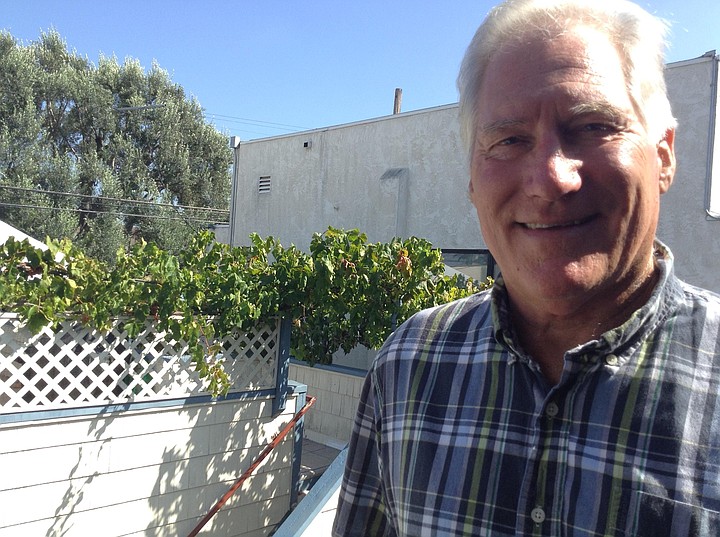 Facebook
Facebook
 X
X
 Instagram
Instagram
 TikTok
TikTok
 Youtube
Youtube

He won’t say how he got it, but Steve “Kim” Moreno says he has a cutting from one of the original Mission vines that Father Junípero Serra brought up with him from Mexico in 1769. “I’m expecting our first vintage in 2017,” says Moreno.
Kim Moreno lives in Coronado, but that hasn’t stopped him from growing his own grapes and turning them into wine over the past few years. He knows a little about the subject: he had a full-fledged vineyard in Virginia where he produced a respected claret. Since moving to Coronado, he has espaliered King’s Ruby grapevines successfully along his fences.

“King’s Ruby is a sweet table grape, but I burn off some of the sweetness so the wine tastes more like the claret I used to make in Virginia,” he says. “Last year I harvested enough wine to fill two cases. About 27 bottles.”

Now his passion is to bring back the original Mission grape and turn it into wine, especially in time for the 250th anniversary of Father Junípero’s arrival here, which will be in 2019. “People don’t think of San Diego as a serious wine-growing district anymore,” he says. “But Napa Valley, Sonoma County — they’re all Johnny-come-lately compared with San Diego.”
He’s right: Most of the Northern California wine industry happened with the influx of gold-rush immigrants in the mid-1850s. Almost a century earlier, Serra and his “leatherjackets,” the Spanish soldiers sent to protect him and the missions he started, came with cuttings of the “vitis vinifera,” the “common black grape” that Hernán Cortés brought with him to the New World in 1520.
Because Serra and his fellow Franciscans planted this grape at all of the missions of Alta California, it came to be known as the Mission variety and was the dominant California grape until the 20th Century.
Mission wines had been initially grown to provide wine for use in religious sacraments. But the dismantling of the mission system after 1834, the gold rush and the importation of new vines that followed, and most of all prohibition in 1919 with its subsequent destruction of so many vineyards proved too much for the humble Mission grape. When the California wine industry finally got back on its feet, the Mission variety had been bypassed. And so had San Diego as a respected viticulture region.
Moreno wants to change that. “We are the birthplace of the California wine industry!” he says. “I want us to get a little respect. Or at least I want to make a little wine that will make a great conversation piece.”


He won’t say how he got it, but Steve “Kim” Moreno says he has a cutting from one of the original Mission vines that Father Junípero Serra brought up with him from Mexico in 1769. “I’m expecting our first vintage in 2017,” says Moreno.
Kim Moreno lives in Coronado, but that hasn’t stopped him from growing his own grapes and turning them into wine over the past few years. He knows a little about the subject: he had a full-fledged vineyard in Virginia where he produced a respected claret. Since moving to Coronado, he has espaliered King’s Ruby grapevines successfully along his fences.

“King’s Ruby is a sweet table grape, but I burn off some of the sweetness so the wine tastes more like the claret I used to make in Virginia,” he says. “Last year I harvested enough wine to fill two cases. About 27 bottles.”

Now his passion is to bring back the original Mission grape and turn it into wine, especially in time for the 250th anniversary of Father Junípero’s arrival here, which will be in 2019. “People don’t think of San Diego as a serious wine-growing district anymore,” he says. “But Napa Valley, Sonoma County — they’re all Johnny-come-lately compared with San Diego.”
He’s right: Most of the Northern California wine industry happened with the influx of gold-rush immigrants in the mid-1850s. Almost a century earlier, Serra and his “leatherjackets,” the Spanish soldiers sent to protect him and the missions he started, came with cuttings of the “vitis vinifera,” the “common black grape” that Hernán Cortés brought with him to the New World in 1520.
Because Serra and his fellow Franciscans planted this grape at all of the missions of Alta California, it came to be known as the Mission variety and was the dominant California grape until the 20th Century.
Mission wines had been initially grown to provide wine for use in religious sacraments. But the dismantling of the mission system after 1834, the gold rush and the importation of new vines that followed, and most of all prohibition in 1919 with its subsequent destruction of so many vineyards proved too much for the humble Mission grape. When the California wine industry finally got back on its feet, the Mission variety had been bypassed. And so had San Diego as a respected viticulture region.
Moreno wants to change that. “We are the birthplace of the California wine industry!” he says. “I want us to get a little respect. Or at least I want to make a little wine that will make a great conversation piece.”
Comments